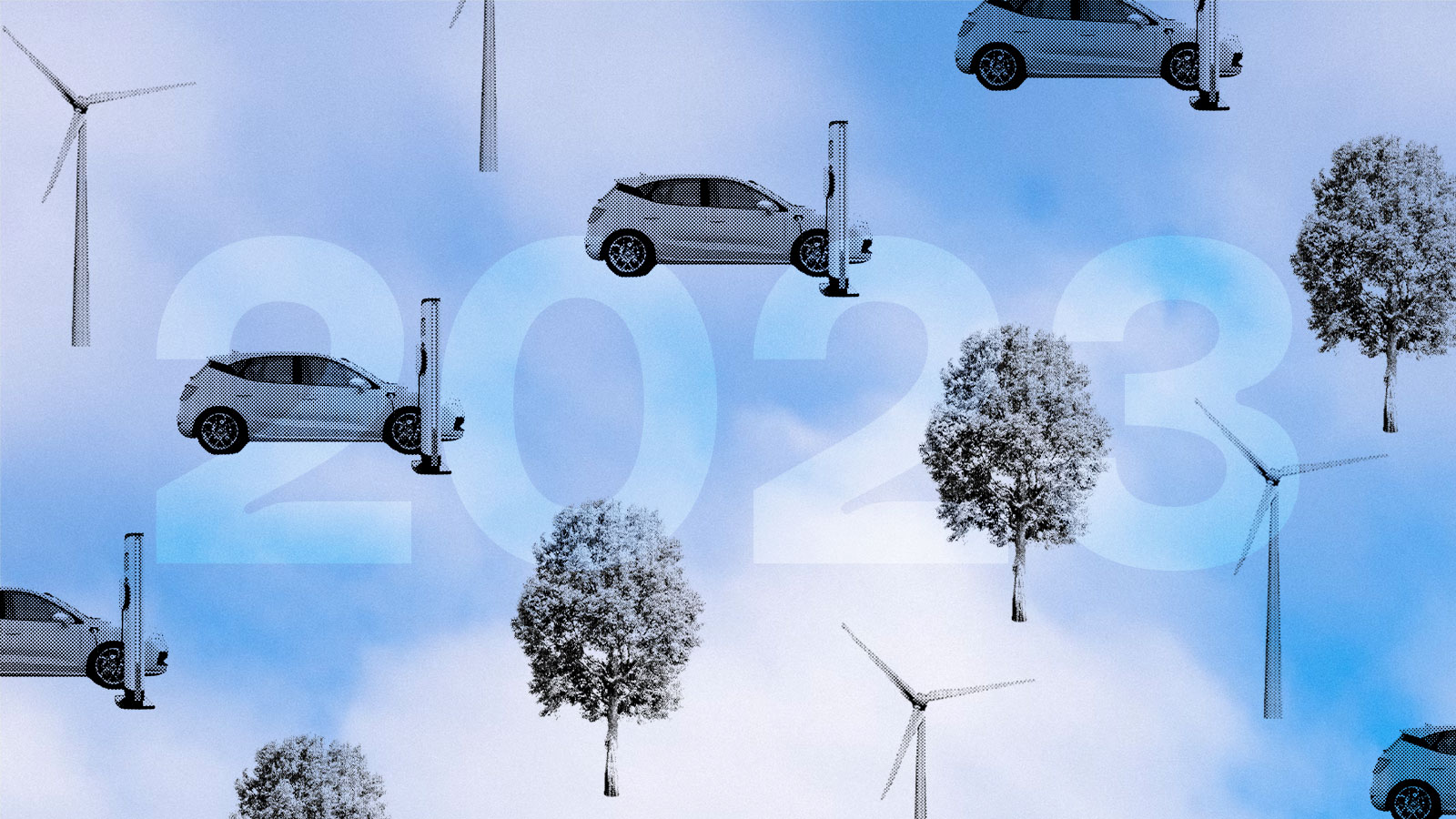Some of the most jarring ways the United States will feel the impacts of climate change began to reveal themselves this year.
The U.S. saw a record-setting 25 billion-dollar natural disasters. Maui experienced the country’s deadliest wildfire in the last century. Phoenix suffered temperatures over 110 degrees Fahrenheit for 31 consecutive days. Vermont endured epic floods. Despite all this, the Biden administration reneged on its promise and approved the Willow oil project in Alaska.
But this year was also filled with news of encouraging, inspiring, and groundbreaking progress in the U.S., not least of which was its joining a global agreement to transition away from fossil fuels and pledging with its biggest rival, China, to accelerate renewables.
Reaching net-zero emissions by 2050 will require decarbonizing the nation’s energy production, transportation, homes and buildings, and industries. Here’s a look back at some of the progress the U.S. made in 2023, seen through the lens of the stories Grist told.
Shoring up clean energy
Electricity generation accounts for about one-quarter of U.S. greenhouse gas emissions. Eliminating them means transitioning to renewable energy. The country made new commitments to do so this year: In addition to the COP28 agreement, the U.S. and China bilaterally agreed to accelerate renewable energy deployment this decade.
That will require speeding up the rate at which such projects are permitted. The Biden administration proposed a rule to streamline this process while requiring agencies to consider environmental justice in their reviews. For its part, the Bureau of Land Management approved 50 clean energy projects on federal lands in the last two years, including a 732-mile transmission line across the West. It also proposed lowering the fees for wind and solar development by 80 percent.
States, tribes, and U.S. territories are trying to accelerate progress too: New Yorkers voted to allow its public power authority to build renewable energy projects, and Michigan’s legislature passed a package of bills requiring the state to run off 100 percent clean energy by 2040. Arizona’s Gila River Indian Community approved the nation’s first solar canal project, and Puerto Rico is receiving half a billion dollars to bring rooftop solar to those who need it most.
Speaking of solar, a recycling industry is cropping up to take in old photovoltaic panels. Washington state even passed a law requiring companies take back and recycle them upon retirement.
Retiring fossil fuels
Ramping up renewable energy capacity makes it possible to retire fossil fuel energy. Coal-fired electricity capacity in the U.S. is down 42 percent from its peak in 2011, and 40 percent of what remains is expected to retire by 2030.
Still, ditching coal requires supporting communities whose economies have long depended on it. Southwestern Virginia has been mining coal since 1880, but the area is beginning to benefit from solar. The industry is gaining trust by creating local jobs and building arrays for schools, saving them money on their utility bills. Even the mines are getting a second chance — scientists are finding rare species like the green salamander returning to areas once stripped for extraction.
Stay on top of climate solutions all year. Subscribe to the Beacon newsletter for a weekly roundup of climate progress.
Looking beyond old coal sites, hundreds of thousands of abandoned oil wells dot the country, polluting the air and water. A federal cleanup program is directing more money than ever before toward capping these wells while creating jobs.
Still, the country broke its oil production records this year. But there are efforts to restrain that boom: New Mexico issued a moratorium on new oil and gas leases near schools and daycare centers, and the Interior Department banned them within a 10-mile radius of the state’s Chaco Culture National Historical Park. The Environmental Protection Agency introduced sweeping regulations that it says could reduce methane emissions from oil and gas by 80 percent.
Capturing carbon
Despite the nation’s best efforts to stop emissions, research shows that limiting global warming to 1.5 degrees Celsius will also require removing hundreds of gigatons of atmospheric carbon dioxide. Whether to do that with machines or through natural solutions is a matter of intense debate.
Opponents of technologies like direct-air capture warn the oil and gas industry could use them to justify prolonging fossil fuel use. But the Biden administration is supporting direct air capture by sending $1 billion to two planned facilities on the Gulf Coast each designed to initially capture up to 1 million metric tons of CO2 annually.
Meanwhile, we’re gaining a better understanding of how natural solutions can promote sequestration. Wetlands, for example, can serve as vast carbon sinks. Louisiana has begun a $3 billion project to restore them, hoping to bring back 21 square miles of land to the coast. Trees are also powerful carbon keepers, and restoring them can cool urban heat islands. As part of a tree-equity “collaborative,” Seattle pledged to plant 8,000 trees and 40,000 seedlings in an effort to cover one-third of the city in tree canopy by 2037.
Scientists are even finding that returning animals to their native ecosystems can help sequester carbon in the soil. The Biden administration is funding the restoration of American bison, which help grasslands retain carbon in the soil as they graze and stomp.
Reimagining mobility
Some of the most encouraging signs of progress this year came from electric vehicles. Transportation accounts for nearly one-third of U.S. greenhouse gas emissions, and most of that pollution comes from cars and trucks. People in the U.S. bought more than 1 million EVs this year, and the country could have 30 million of them by 2030.
To manage this transition, the nation needs hundreds of thousands of public charging ports, and it is racing to build them. A $5 billion federal program is underway to install them along the nation’s highways. California hit 10,000 public EV fast chargers this year, and Walmart announced plans to build its own network. Tesla is opening its vast charging network to other automakers.
EVs won’t just change how we get around — their batteries can transform how we power our homes and even the grid. When those batteries retire, they could lead a productive second life as storage for clean energy before being recycled at one of the numerous recycling facilities being built all over the country.
While 95 percent of the critical materials in batteries are infinitely recyclable, we need to reduce our reliance on cars to minimize how much of these materials we extract from the earth. Electric buses or new passenger rail lines like the one that opened in Honolulu will help, as will micromobility programs like a nonprofit community-led bikeshare in New Orleans.
Building better
Heating, cooling, and powering homes and other buildings takes a lot of energy. Although emerging technologies can lower the impacts of doing so, the first place to start is improving the efficiency of those structures so they require less power in the first place.
People nationwide discovered efficiency hacks like insulated shades and exterior window awnings as they battled extreme heat. The Lower Sioux in Minnesota are creating sustainable home insulation using “hempcrete,” which they grow and process in their own facility.
But even the most efficient homes still need some heating and cooling. That’s why 25* governors went all-in on heat pumps, pledging to install 20 million of them by 2030. They can take lessons from Maine, which has the highest per-capita adoption in the country. In 2024, states will start administering Inflation Reduction Act rebates on electric appliances like heat pumps, making them more affordable. Of course, installing them will require training a whole lot of electricians. And while Berkeley, California’s ban on natural-gas in new buildings was struck down in court this April, other cities are finding workarounds to the ruling, like requiring apartment buildings to reach net-zero emissions by 2050.
Some researchers are looking at mobile homes as a climate solution, because prefabricated homes can come equipped with solar panels and heat pumps. An equity-driven program in Ithaca, New York, is installing them in already existing mobile homes.
Cleaning up dirty business
As consumers make their own efforts toward decarbonization, it’s becoming easier for them to see what commitments businesses are making toward net-zero. Although a federal requirement that they disclose greenhouse gas emissions is still forthcoming, California passed its own climate disclosure laws requiring companies that make over $1 billion annually to reveal all of their greenhouse gas emissions and the content of the carbon offsets they buy.
Companies that rely on or produce plastics also experienced more pressure to improve their practices. New York State is suing PepsiCo for its role in polluting the Buffalo River watershed. Businesses that over utilize single-use packaging are getting competition from zero-waste entrepreneurs who offer customers better options for refilling containers like shampoo and detergent bottles.
There’s still a long way to go on decarbonizing some of the country’s most polluting industries, like steel and concrete. The race for green steel is on, as evidenced by big investments in ideas for removing coal from its production. Startups are also working on carbon-negative concrete and even formulas that store carbon inside the material.
Even the U.S. cattle industry could see disruption, since the USDA approved the sale of lab-grown meat. Perhaps an even bigger threat to Big Ag? Teenagers. A Los Angeles teen sued her school district and the USDA over their milk mandates.
Which leads us to perhaps the most encouraging solutions story of the year: The mobilization of young people who are fighting for their right to a safe, healthy, and promising future. Kids won big in Held v. Montana, which could bode well for the 14 youth in Hawaiʻi who are taking their state’s transportation department to court, and the 18 young Californians who just filed a lawsuit against the Environmental Protection Agency for discriminating against children by not protecting them from pollution. With kids like these leading the climate movement, next year could have much more to celebrate.
*Correction: This article originally stated that 20 governors are part of the commitment to install 20 million heat pumps by 2030. The actual number is 25.
Get a roundup of climate progress and solutions every Friday in your inbox. Sign up for the Beacon newsletter to stay informed all year.



